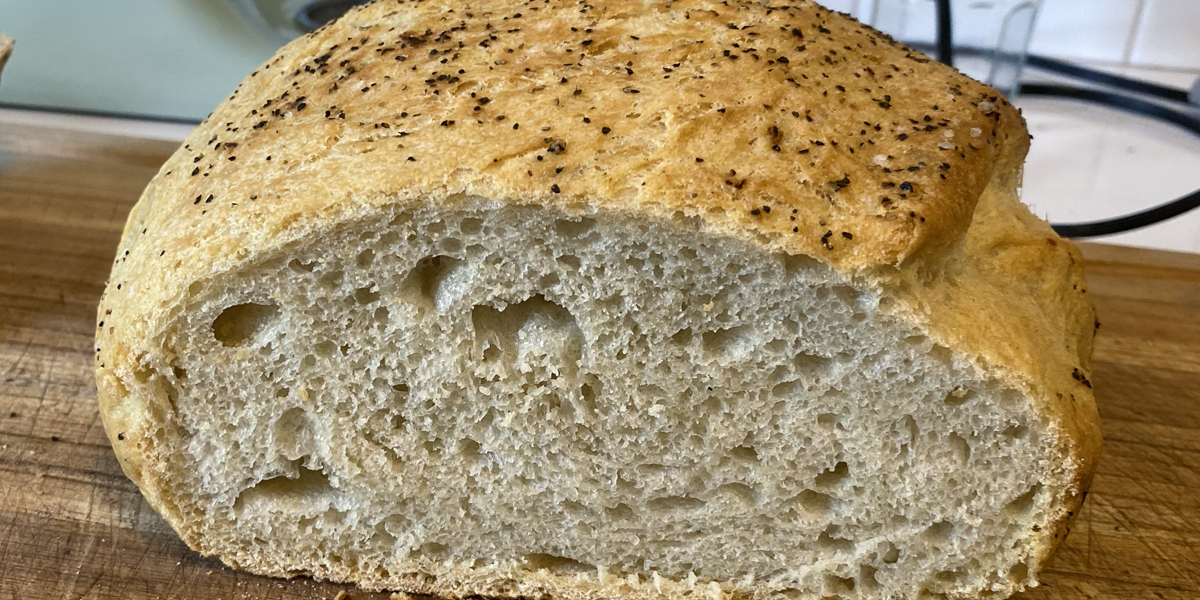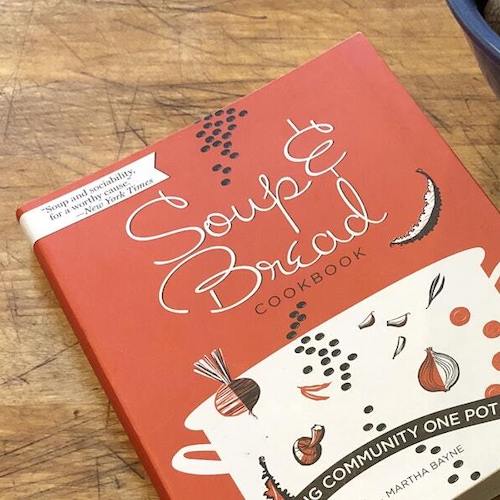Makes one loaf
You’ll need a Dutch oven or a suitable substitute. I use a 5.5-quart Le Creuset “deep oven,” which gives this bread a little more height than the standard version.
Ingredients
Scant 2 cups warm water
2 ¼ tsp. instant yeast (1 packet)
4 cups all-purpose flour, lightly packed, plus a few extra tbsp.
1 tsp. kosher salt
1 tbsp. olive oil
Maldon or other flaky sea salt, to taste
Coarsely ground black pepper, to taste
Preparation
Stir the yeast into the warm water. Mix thoroughly.
Mix the flour and salt (not the Maldon, that’s for later) in a large bowl. Use one hand, keeping the other clean.
Mix the water-and-yeast mixture into the flour and salt using that same hand. It’s going to be sticky as hell—stickier than you think bread dough should be. If more of it is sticking to your hand than staying in the bowl, add some flour, 1 tbsp. at a time, until it’s better. You should still need to wash a bunch of dough off your hand when you’re done.
In the end, you should have a ball, but it won’t look smooth. Wash your mixing hand, cover the bowl with a kitchen towel, and let the dough rise for two hours.
After that time, the dough should have risen considerably. It should look gooey and pock-marked. Poke it a few times and it will lose most of the size it gained.
Using your hand or a spatula, pull the sides of the dough toward the center of the bowl, unsticking it from the bottom and reshaping it into a ball roughly the same size you started with. Feel free to add 1 tbsp. or so of flour to make it easier to work with. Cover the dough again and let it rise for 90 more minutes.
Transfer the dough to a generously floured surface. Then, if you’re lazy like me or only have one suitable bowl, wash the bowl that you’ve been using thoroughly. You’ll need it again shortly.
Add another sprinkling of flour to the top of your dough and knead it just a little bit. Really you should just fold it on top of itself a few times, incorporating that extra flour, resulting in something that looks more like a traditional bread dough. If it still hasn’t smoothed out, sprinkle on more flour and work that in until it does.
Add olive oil to your nice, clean bowl, followed by another dusting of flour. Transfer your dough to the bowl, then flip the dough over so that each side gets a light coating of olive oil. Sprinkle one side with salt flakes, followed by a generous amount of coarsely ground black pepper. Flip it over and do the same on the other side. Cover and let it rise for 45-60 more minutes.
Preheat the oven to 450 degrees. Put your Dutch oven in the oven-oven while it heats, lid and all. (Make sure your knob is safe at that temperature. If it’s not, screw it off and set it aside.) Once the oven is preheated, carefully remove the Dutch oven. Dump the dough ball into the pot carefully. It should slide out of its bowl easily. Shake it around just a bit to ensure that the dough distributes evenly. Cover the pot and return it to the oven.
Bake for 25 minutes with the cover on, then carefully remove the cover and return it to the oven for 12 more minutes. This is considerably less baking time than similar recipes call for, but if you’re worried about making sure your bread is fully baked, you can use an instant-read thermometer in the bottom. It should be at about 200 degrees when it’s done. It will also be a lovely golden brown.
Remove the pot from the oven, but leave the bread in the Dutch oven, uncovered, for about two minutes, before carefully flipping it on to a cooling rack. In about 10-15 minutes, it will attain perfection. It will stay that way for just a few hours. My wife and I slather it with Kerrygold butter. Our 10-year-old son likes strawberry jam. You can dip it in a hearty stew or make a cheese-and-summer-sausage sandwich. While the taste and texture are still very good the following day, the bread loses some of its magic as it sits. It’s also delicious enough that you likely won’t have any leftovers anyway.





